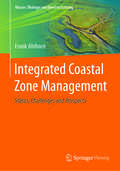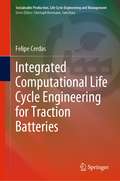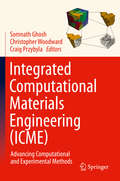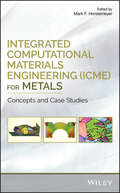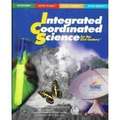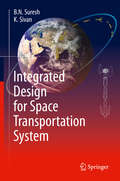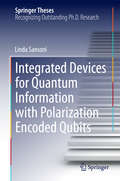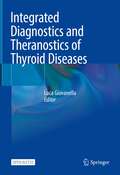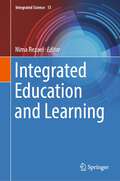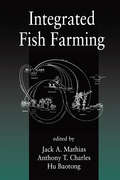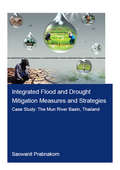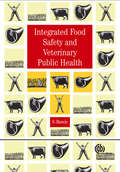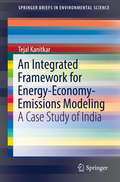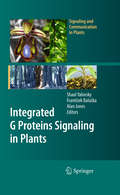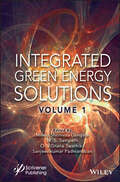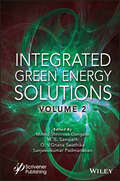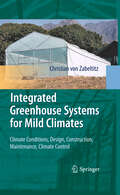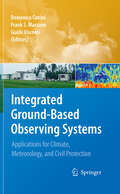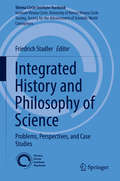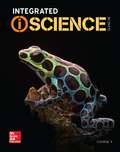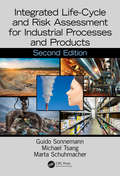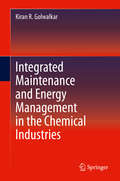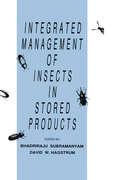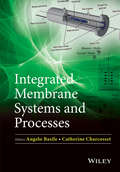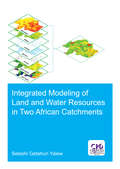- Table View
- List View
Integrated Coastal Zone Management: Status, Challenges and Prospects (Wasser: Ökologie und Bewirtschaftung)
by Frank AhlhornThe Book gives an overview about the Integrated Coastal Zone Management and offers examples and best practice. The focus is set on European coastal zones, worldwide and historical developements are considered also. Questons at the end of each chapter enable the consolidation of the matter.
Integrated Computational Life Cycle Engineering for Traction Batteries (Sustainable Production, Life Cycle Engineering and Management)
by Felipe CerdasThe environmental burden caused by private transportation represents a significant challenge towards sustainability. Electric vehicles are considered a key technology to reduce the environmental impact caused by the mobility sector. However, the global adoption of electromobility implies shift and diversification of the environmental impacts caused by the transportation sector mainly driven by the production of the battery system. Modeling the life cycle environmental impacts of traction batteries is a time demanding and interdisciplinary task as it involves a high variability and requires an in-depth knowledge of the product system under analysis. To face these challenges, an Integrated Computational Life Cycle Engineering ICLCE framework for EVs has been developed. The ICLCE framework described aims at supporting fast and comprehensive modelling of complex foreground systems in the electromobility field and their interaction with diverse backgrounds and partial contexts.
Integrated Computational Materials Engineering (ICME): Advancing Computational and Experimental Methods
by Christopher Woodward Somnath Ghosh Craig PrzybylaThis book introduces research advances in Integrated Computational Materials Engineering (ICME) that have taken place under the aegis of the AFOSR/AFRL sponsored Center of Excellence on Integrated Materials Modeling (CEIMM) at Johns Hopkins University. Its author team consists of leading researchers in ICME from prominent academic institutions and the Air Force Research Laboratory. The book examines state-of-the-art advances in physics-based, multi-scale, computational-experimental methods and models for structural materials like polymer-matrix composites and metallic alloys. The book emphasizes Ni-based superalloys and epoxy matrix carbon-fiber composites and encompasses atomistic scales, meso-scales of coarse-grained models and discrete dislocations, and micro-scales of poly-phase and polycrystalline microstructures. Other critical phenomena investigated include the relationship between microstructural morphology, crystallography, and mechanisms to the material response at different scales; methods of identifying representative volume elements using microstructure and material characterization, and robust deterministic and probabilistic modeling of deformation and damage. Encompassing a slate of topics that enable readers to comprehend and approach ICME-related issues involved in predicting material performance and failure, the book is ideal for mechanical, civil, and aerospace engineers, and materials scientists, in in academic, government, and industrial laboratories.
Integrated Computational Materials Engineering (ICME) for Metals: Concepts and Case Studies
by Mark F. HorstemeyerFocuses entirely on demystifying the field and subject of ICME and provides step-by-step guidance on its industrial application via case studies This highly-anticipated follow-up to Mark F. Horstemeyer’s pedagogical book on Integrated Computational Materials Engineering (ICME) concepts includes engineering practice case studies related to the analysis, design, and use of structural metal alloys. A welcome supplement to the first book—which includes the theory and methods required for teaching the subject in the classroom—Integrated Computational Materials Engineering (ICME) For Metals: Concepts and Case Studies focuses on engineering applications that have occurred in industries demonstrating the ICME methodologies, and aims to catalyze industrial diffusion of ICME technologies throughout the world. The recent confluence of smaller desktop computers with enhanced computing power coupled with the emergence of physically-based material models has created the clear trend for modeling and simulation in product design, which helped create a need to integrate more knowledge into materials processing and product performance. Integrated Computational Materials Engineering (ICME) For Metals: Case Studies educates those seeking that knowledge with chapters covering: Body Centered Cubic Materials; Designing An Interatomic Potential For Fe-C Alloys; Phase-Field Crystal Modeling; Simulating Dislocation Plasticity in BCC Metals by Integrating Fundamental Concepts with Macroscale Models; Steel Powder Metal Modeling; Hexagonal Close Packed Materials; Multiscale Modeling of Pure Nickel; Predicting Constitutive Equations for Materials Design; and more. Presents case studies that connect modeling and simulation for different materials' processing methods for metal alloys Demonstrates several practical engineering problems to encourage industry to employ ICME ideas Introduces a new simulation-based design paradigm Provides web access to microstructure-sensitive models and experimental database Integrated Computational Materials Engineering (ICME) For Metals: Case Studies is a must-have book for researchers and industry professionals aiming to comprehend and employ ICME in the design and development of new materials.
Integrated Coordinated Science for the 21st Century
by Gary Freebury Ruta Demery Robert Ritter Arthur Eisenkraft John B. Southard Michael SmithIntegrated Coordinated Science for the 21st Century is an innovative core curricula assembled from four proven inquiry-based programs.
Integrated Design for Space Transportation System
by B. N. Suresh K. SivanThe book addresses the overall integrated design aspects of a space transportation system involving several disciplines like propulsion, vehicle structures, aerodynamics, flight mechanics, navigation, guidance and control systems, stage auxiliary systems, thermal systems etc. and discusses the system approach for design, trade off analysis, system life cycle considerations, important aspects in mission management, the risk assessment, etc. There are several books authored to describe the design aspects of various areas, viz. , propulsion, aerodynamics, structures, control, etc. , but there is no book which presents space transportation system (STS) design in an integrated manner. This book attempts to fill this gap by addressing systems approach for STS design, highlighting the integrated design aspects, interactions between various subsystems and interdependencies. The main focus is towards the complex integrated design to arrive at an optimum, robust and cost effective space transportation system. The orbital mechanics of satellites including different coordinate frames, orbital perturbations and orbital transfers are explained. For launching the satellites to meet specific mission requirements, viz. , payload/orbit, design considerations, giving step by step procedure are briefed. The selection methodology for launch vehicle configuration, its optimum staging and the factors which influence the vehicle performance are summarized. The influence of external, internal and dynamic operating environments experienced by the vehicle subsystems and the remedial measures needed are highlighted. The mission design strategies and their influence on the vehicle design process are elaborated. The various critical aspects of STS subsystems like flight mechanics, propulsion, structures and materials, thermal systems, stage auxiliary systems, navigation, guidance and control and the interdependencies and interactions between them are covered. The design guidelines, complexity of the flight environment and the reentry dynamics for the reentry missions are included. The book is not targeted as a design tool for any particular discipline or subsystem. Some of the design related equations or expressions are not attempted to derive from the first principle as this is beyond the scope of this book. However, the important analytical expressions, graphs and sketches which are essential to provide in-depth understanding for the design process as well as to understand the interactions between different subsystems are appropriately included.
Integrated Devices for Quantum Information with Polarization Encoded Qubits
by Linda SansoniQuantum information science has found great experimental success by exploiting single photons. To date, however, the majority of quantum optical experiments use large-scale (bulk) optical elements bolted down to an optical bench, an approach that ultimately limits the complexity and stability of the quantum circuits required for quantum science and technology. The realization of complex optical schemes involving large numbers of elements requires the introduction of waveguide technology to achieve the desired scalability, stability and miniaturization of the device. This thesis reports on surprising findings in the field of integrated devices for quantum information. Here the polarization of the photon is shown to offer a suitable degree of freedom for encoding quantum information in integrated systems. The most important results concern: the quantum interference of polarization entangled photons in an on-chip directional coupler; the realization of a Controlled-NOT (CNOT) gate operating with polarization qubits; the realization of a quantum walk of bosons and fermions in an ordered optical lattice and the quantum simulation of Anderson localization of bosons and fermions simulated by polarization entangled photons in a disordered quantum walk. The findings presented in this thesis represent an important step towards the integration of a complete quantum photonic experiment in a chip.
Integrated Diagnostics and Theranostics of Thyroid Diseases
by Luca GiovanellaThis open access book provides basic concepts on Integrated Diagnostics and Theranostics with special emphasis on different human thyroid diseases. Thyroid diseases are increasingly detected (incidentally in many cases) but are clinically negligible in a significant proportion of patients. Accordingly, it is urgent to move from the simple disease detection to a reliable disease characterization in order to concentrate efforts on patients in need of tailored disease management. The current scenario of in vitro and in vivo diagnostics, is fastly moving toward the Integrated Diagnostics (i.e. convergence of imaging, pathology and laboratory tests with advanced information technology). Furthermore, the integration of different information will aid clinicians to properly select treatments and stratify patients’ prognosis over time. Theranostics is a perfect paradigm of such integrated approach and radioiodine, indicated for benign and malignant thyroid disease management, was the first and is still the mostly used theranostic agent in medicine. Featuring basics concepts and clinical cases discussions the Atlas will be an invaluable tool for clinicians, laboratory specialists, imaging physicians and biomedical technologists involved in diagnosis and therapy of thyroid diseases.
Integrated Education and Learning (Integrated Science #13)
by Nima RezaeiIntegrated Education and Learning aims to discuss novel approaches to offer integrated educational methods. Within the last few years, educational techniques have evolved to favour critical thinking and improve learning skills. This volume links thinking and learning in educational settings and discusses diverse mechanisms that influence this association; including meta-cognitive capacity, memory, cognitive style, conceptual approaches, digitalization, teaching approaches, echoing, and questioning. It embraces this discussion at all levels, from early childhood education to higher education. This book also includes teaching tips for creating a learning environment that cultivates students’ creativity and critical thinking on both online platforms and live-in-classroom. The book follows discussing the merits of an integrated educational paradigm that will help develop highly intellectual thinkers and will promote modern values to face current and future challenges. Finally, the book shows a balance between learning and education to enhance creativity, critical thinking and social skills.
Integrated Fish Farming
by Jack A. Mathias Charles AnthonyIf you are looking for wide-ranging international coverage of all aspects of integrated fish forming, this is the book you need. With a carefully selected and fully interdisciplinary collection of papers from experts around the world, Integrated Fish Farming provides thorough, detailed coverage of one of the world's most important approaches to integrated farming systems. Integrated Fish Fanning places IFF in a global context, reporting on case studies of successful IFF operations, experiments to enhance IFF performance, bioeconomic survey and modeling analyses, research on farm waste use and pond ecology, socio-economic elements of IFF extension and adoption, and the bio-technical and economic aspects of adapting IFF to reservoirs, marshlands, rice paddies, and marginal habitats. With contributions from leading international authorities and in-depth information from IFF operations worldwide, this is the definitive reference on Integrated Fish Farming.
Integrated Flood and Drought Mitigation Mesures and Strategies. Case Study: The Mun River Basin, Thailand (IHE Delft PhD Thesis Series)
by Saowanit PrabnakornFloods and droughts are climate extremes that account for more than 80% of people affected by natural disasters worldwide. Both catastrophes co-exist in many river basins, for example, the Mun River Basin in Thailand, which is selected as the study area. Approximately 90% of rice cultivation here is rain-fed, and that results in the lowest yields in the country, making many farmers persist in poverty. This study aims to assess floods and droughts and their impacts on agriculture at the basin scale. For flooding, the hydrologic and hydraulic models were developed to produce the first completed flood hazard maps at the Mun River Basin. Droughts in the basin were determined by the proposed drought risk assessment scheme that combines all three key components (hazard, exposure, and vulnerability). Subsequently, the study attempts to tackle both floods and droughts simultaneously and sustainably by using integrated measures and strategies. If the problems caused by flood and drought climate extremes are solved, this will ensure adequate food availability and alleviate poverty in the basin. Furthermore, the study shows that a holistic approach to simultaneously solving both problems is efficient as most water will be utilized to benefit agriculture, the primary sector that feeds a growing population.
Integrated Food Safety and Veterinary Public Health
by Sava BuncicThe importance of food safety for human health has been widely recognized. The safety of foods of animal origin is particularly relevant because the large majority of food-borne diseases come from poultry, eggs, meat, milk and dairy products and fish. This textbook covers an integrated approach to this type of food production, hygiene and safety and shows how it results in concurrent benefits to animal well being, human health, protection of the environment and socioeconomics.
An Integrated Framework for Energy-Economy-Emissions Modeling: A Case Study of India (SpringerBriefs in Environmental Science)
by Tejal KanitkarThis book combines three different energy-economy-emissions modeling methodologies into one Integrated Modeling Framework (IMF) in an attempt to fill gaps in current modeling research as it applies to developing countries. Through the analysis of existing mathematical models, including large macro-economic models and technology-explicit energy models, the work proposes planning methodologies for developing countries that face challenges on their economy and infrastructure due to climate change. The three modeling methodologies discussed in the chapters are a decomposition analysis of trends in emissions intensity of GDP, linear programming techniques to determine optimum energy supply pathways given various resource and emissions constraints, and an input-output analysis to evaluate the impact of energy policies on income and equity. After a brief introduction to the history of the development of energy studies and the linkages between energy, economic, and environmental systems, the book delves into the component methodologies of the IMF and their intended outcomes. The decomposition analysis is intended to gauge the energy intensity of GDP and the structural composition of the economy to provide a basis on which scenarios are constructed in the following two methodologies. The linear programs are meant to develop a methodology to determine energy options under a variety of scenarios that capture the technical and economic characteristics of the power sector of developing countries. Lastly, the input-output analysis aims to build a methodology through which energy policy decisions can be understood and quantified to ensure the best possible impacts on developing economies and societies. Those who will be interested in this book include policy makers, academics, and students and professionals working on energy studies and energy-economy modeling.
Integrated G Proteins Signaling in Plants
by František Baluška Shaul Yalovsky Alan JonesThis volume focuses on the structure, function and regulation of plant signaling G proteins and their function in hormonal pathways, polarity, differentiation, morphogenesis and responses to biotic and abiotic stresses. Plants are sessile organisms that need to continuously coordinate between external and internal cues. This coordination requires the existence of hubs to allow cross-talk between different signaling pathways. A single family of Rho GTPases, termed either ROPS or RACs, and heterotrimeric G proteins have emerged as the major molecular switches in a multitude of signal transduction pathway in plants.
Integrated Green Energy Solutions, Volume 1
by Milind Shrinivas Dangate W. S. Sampath O.V. Gnana Swathika P. SanjeevikumarINTEGRATED GREEN ENERGY SOLUTIONS This first volume in a two-volume set presents the state of the art for the concepts, practical applications, and future of renewable energy and how to move closer to true sustainability. Renewable energy supplies are of ever-increasing environmental and economic importance in every country worldwide. A wide range of renewable energy technologies has been established commercially and recognized as an important set of growth industries for most governments. World agencies, including the United Nations, have extensive programs to encourage these emerging technologies. This book will bridge the gap between descriptive reviews and specialized engineering technologies. It centers on demonstrating how fundamental physical processes govern renewable energy resources and their applications. Although the applications are updated continually, the fundamental principles remain the same, and this book will provide a useful platform for those advancing the subject and its industries. Integrated Resilient Energy Solutions is a two-volume set covering subjects of proven technical and economic importance worldwide. Energy supply from renewables is an essential component of every nation’s strategy, especially when there is responsibility for the environment and sustainability. These two volumes will consider the timeless renewable energy technologies’ principles yet demonstrate modern applications and case studies. Whether for the veteran engineer, student, or other professional, these two volumes are a must-have for any library.
Integrated Green Energy Solutions, Volume 2
by Milind Shrinivas Dangate W. S. Sampath O.V. Gnana Swathika P. SanjeevikumarINTEGRATED GREEN ENERGY SOLUTIONS This second volume in a two-volume set continues to present the state of the art for the concepts, practical applications, and future of renewable energy and how to move closer to true sustainability. Renewable energy supplies are of ever-increasing environmental and economic importance in every country in the world. A wide range of renewable energy technologies has been established commercially and recognized as an important set of growth industries for most governments. World agencies, such as the United Nations, have extensive programs to encourage these emerging technologies. This book will bridge the gap between descriptive reviews and specialized engineering technologies. It centers on demonstrating how fundamental physical processes govern renewable energy resources and their applications. Although the applications are being updated continually, the fundamental principles remain the same, and this book will provide a useful platform for those advancing the subject and its industries. Integrated Resilient Energy Solutions is a two-volume set covering subjects of proven technical and economic importance worldwide. Energy supply from renewables is an essential component of every nation’s strategy, especially when there is responsibility for the environment and sustainability. These two volumes will consider the timeless renewable energy technologies’ principles yet demonstrate modern applications and case studies. Whether for the veteran engineer, student, or other professional, these two volumes are a must-have for any library.
Integrated Greenhouse Systems for Mild Climates
by Christian Von ZabeltitzCrop production in greenhouses is a growing industry, especially in mild climates, and is very important for the population as a source of income and clean, fresh food. Greenhouses create optimal climate conditions for crop growth and protect crops from outside pests. At the same time greenhouse production increases water use efficiency and makes integrated production and protection (IPP) possible. This book provides technical instructions for practice (what to do and what not to do) and gives answers to the question: How to produce more clean crops and better quality with less water, less land and less pesticide. Suitable greenhouse constructions and their design, adapted to local climates in subtropical, tropical and arid regions and infrastructure conditions are presented. The necessary climate control measures - light transmittance, ventilation, cooling, heating, and CO2 enrichment - and physical measures for pest control, as well as methods for using solar energy to desalinate salty water are described. The results of theoretical research are transferred into methods for practical use, so that readers are equipped to solve their problems in practice as well as to get stimulation for further research and development.
Integrated Ground-Based Observing Systems
by Domenico Cimini Frank S. Marzano Guido ViscontiThe book is a collection of the lectures delivered during the 7th International Summer School on Atmospheric and Oceanic Sciences (ISSAOS) titled "Integrated Ground-Based Observing Systems Applications for Climate, Meteorology, and Civil Protection". Its aim is to contribute to the scientific understanding of basic concepts and applications of integrated ground-based observing systems. The first part describes the most common instrumentations showing their strengths and limitations. Furthermore, strategic plans for the deployment of an observation site are discussed along with an overview of techniques for integrating heterogeneous data. The second part introduces cutting-edge applications, including assimilation in numerical weather prediction, climate benchmarking, air quality monitoring and meteo/hydrological warnings.
Integrated History and Philosophy of Science
by Friedrich StadlerThis book features papers on the history and philosophy of science. It also includes related reviews of recent research literature on Rudolf Carnap, Eino Kaila, Ernst Mach, and Otto Neurath. The central idea behind this volume is that this distinctive field is both historical and philosophical at the same time. Good history and philosophy of science is not just history of science into which some philosophy of science may enter. On the other hand, it is neither philosophy of science into which some history of science may enter. The founding insight of this modern research discipline is that history and philosophy have a special affinity and one can effectively advance both simultaneously. The selection of contributions collected in this volume are good examples and best practices for these claims. In addition, it includes illuminating case studies. It will appeal to scholars in the history of and philosophy of science, especially history and philosophy of physics and biology, as well as economics, extended evolution, and the history of knowledge.
Integrated iScience, Course 1
by McGraw-Hill Education StaffIntegrated iScience blends life, earth, and physical science topics in three courses, specific to each grade. Integrated iScience Course 1 focuses on the methods of science and covers topics in life, earth, and physical science. Units include: The Nature of Science, Exploring Life, Understanding Matter, and Understanding Energy. The text's pedagogy (chapter outlines, core concept maps, and overviews) reveals how the science disciplines are interrelated and integrated throughout the text. It continues to introduce basic concepts and key ideas while providing opportunities for students to learn reasoning skills and a new way of thinking about their environment. iScience meets students where they are through engaging graphic novel-style features and thought-provoking questions that encourage them to relate the science concepts to the world around them. The inquiry-based 5E lesson cycle provides active, hands-on explorations of the concepts. Includes: Integrated iScience Course 1 Print Student Edition
Integrated Life-Cycle and Risk Assessment for Industrial Processes and Products (Advanced Methods in Resource & Waste Management)
by Guido Sonnemann Michael Tsang Marta SchuhmacherLife-cycle assessment is a methodology used to evaluate the environmental impacts of a product, process, or service during its life cycle, and risk assessment is a tool to evaluate potential hazards to human health and the environment introduced by pollutant emissions. The United Nations Sustainable Development Goals call for, among other objectives, responsible consumption and production by decoupling environmental resource use and environmental impacts from economic growth and human well-being. Life-cycle assessment and risk assessment are both analytical system approaches that allow scientists and other decision makers to address these issues and objectives according to the current understanding of environmental mechanisms. This book is the first attempt to illustrate the existing interfaces between life-cycle assessment and risk assessment and to indicate options for further integration of both tools. The second edition: Focuses on sustainability Considers new developments in life-cycle assessment and environmental risk assessment over the last ten years at the international level Introduces broader concepts and discussions on integrative versus the complementary use of life-cycle and risk assessments Extends the scope of integrated life-cycle and risk assessments to critical raw materials Includes more case studies and discusses engineered nanomaterials Featuring contributions from leading experts, Integrated Life-Cycle and Risk Assessment for Industrial Processes and Products is a great reference for graduate students and professionals in environmental management and intends to catalyze communication between life-cycle assessment and risk assessment experts and scientists in academia, industry, and governmental agencies. The practical format of the book—illustrated with flowcharts, examples, exercises, and concrete applications—makes it a useful manual for analyzing situations and making decisions.
Integrated Maintenance and Energy Management in the Chemical Industries
by Kiran R. GolwalkarThis book provides guidelines to ensure a safe and smooth running chemical production plant. It presents in detail such important considerations as selection of proper technology with efficient machinery (for a new plant) or expansion / diversification of existing plants for manufacture of more products for safe and pollution-free operation.This book also provides guidelines for improved plant layout, and selection of raw materials to reduce pre-processing costs prior to feeding to process units. The book further examines procuring better inputs (such as catalysts, filter cloths, tower internals etc) required for smooth plant operation and better product quality for client satisfaction, enhanced process control through suitable instrumentation, and preventive maintenance.Typical conflicts arising in production units due to different priorities among sales departments, purchasing departments, production engineers, and maintenance engineers are addressed. The book also suggests methods to reduce the loss of energy during start up and shutdowns, increase equipment life, and prevent environmental pollution.Case studies are included in appropriate chapters.
Integrated Management of Insects in Stored Products
by Bhadriraju Subramanyam David W. HagstrumThis work offers a comprehensive presentation of the identification, biology, ecology and sampling of insect pests in stored foods, and provides a balanced ciew of the biological, physical and chemical control methods used in pest management. It furnishes step-by-step procedures for creating individually tailored integrated pest management programmes. Every available method of control is covered.
Integrated Membrane Systems and Processes
by Angelo Basile Catherine CharcossetThe book examines the possibility of integrating different membrane unit operations (microfiltration, ultrafiltration, nanofiltration, reverse osmosis, electrodialysis and gas separation) in the same industrial cycle or in combination with conventional separation systems. It gives careful analysis of the technical aspects, and the possible fields of industrial development. The book reviews many original solutions in water desalination, agro-food productions and wastewater treatments, highlighting the advantages achievable in terms of product quality, compactness, rationalization and optimization of productive cycles, reduction of environmental impact and energy saving. Also included are examples of membrane reactors and their integration with a fuel cell; polymeric membranes in the integrated gasification combined cycle power plants; integrating a membrane reformer into a solar system; and potential application of membrane integrated systems in the fusion reactor fuel cycle. With detailed analysis and broad coverage, the book is divided into two sections: Bio-applications and Inorganic Applications.
Integrated Modeling of Land and Water Resources in Two African Catchments
by Seleshi Getahun YalewDemand for land and water for agriculture, urbanization, irrigation, hydropower, and industrialization is increasing to meet the demands of growing populations and of growing economies. However, changes in land and water resources are often studied separately. A better representation of the interaction between land-use change and its drivers on the one hand and water resources on the other is imperative for sustainable environmental management. This research investigates and develops spatial analysis methods and tools for the quantification of dynamic feedbacks between land-use change and water resources, by focusing on case study catchments in Ethiopia and South Africa. Furthermore, the research investigates methods for analysing land-use suitability and modelling land-use change. Results show that major changes in land-use have been observed in the past two to three decades in the study catchments. Model representation of the interaction between land-use change and water resources shows that changes in land-use influence hydrologic responses. These influences are especially pronounced during high- and low-flow seasons. Likewise, hydrologic processes and water resources availability influence land-use suitability and hence land-use change responses. Accounting for the dynamic feedback between land-use and hydrology thus produces improved knowledge that can better inform integrated natural resources management.
